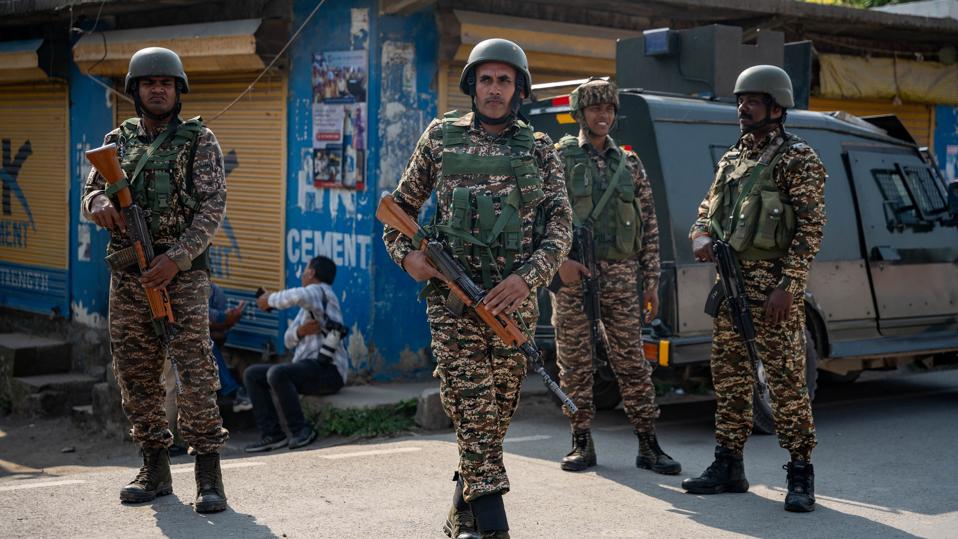Topline
Tensions between India and Pakistan boiled over on Wednesday after India’s military launched overnight airstrikes on what it claims was “terrorist infrastructure” in the neighboring country, two weeks after New Delhi accused Islamabad of being involved in a deadly terror attack that killed 26 civilians in a tourist resort town in Indian-administered Kashmir.
Key Facts
The Indian missile strikes—named “Operation Sindoor”—were carried out early Wednesday local time, and officials in New Delhi claimed they targeted nine locations where “terrorist attacks against India have been planned.”
The strikes were the most significant military operation carried out by India against Pakistan since its 2019 airstrikes on Balakot in Pakistan-administered Kashmir.
India said the Wednesday strikes did not target any Pakistani military infrastructure and claimed it acted on intelligence regarding further “cross-border attacks” being planned against India, which it wanted to deter.
Pakistani officials strongly denounced the strikes, calling them “an unprovoked and blatant act of war” that “violated Pakistan’s sovereignty,” and accused India of using the “false pretext of the presence of imaginary terrorist camps” to carry out the attack.
Islamabad claimed 26 civilians were killed in the strikes and at least 46 others were injured.
Pakistan’s leadership claimed, without sharing evidence, it managed to shoot down five Indian fighter jets, but maintained that it reserved the right to respond to the “unprovoked and unjustified attacks.”
Get Forbes Breaking News Text Alerts: We’re launching text message alerts so you’ll always know the biggest stories shaping the day’s headlines. Text “Alerts” to (201) 335-0739 or sign up here.
What Have Both Sides Said About Further Escalation?
After claiming to shoot down five Indian jets, a claim India has not responded to, Pakistan’s Defense Minister Khawaja Asif signalled any further actions by Pakistan will depend on what India does. “If India attacks, we’ll respond. If India backs down, we’ll definitely wrap up,” he told Bloomberg TV. But the country’s National Security Committee later insisted Pakistan reserved the right to respond to the strikes. In a statement, the committee also urged the “international community to recognize the gravity of India’s unprovoked illegal actions and to hold it accountable for its blatant violations of international norms and laws.” Indian officials have not indicated whether any further strikes are planned, but during a press briefing, Indian Air Force Wing Commander Vyomika Singh said: “The Indian armed forces are fully prepared to respond to Pakistani misadventures, if any, that will escalate the situation.”
What Do We Know About India And Pakistan’s Military Capabilities?
Both India and Pakistan are nuclear-armed countries, which raises the risk of dangerous escalation in the event of an all-out war. According to the CIA’s World Factbook, India has an estimated 1.5 million active military personnel, making it one of the world’s largest militaries. Pakistan, on the other hand, has around 630,000 active-duty personnel. Despite having a larger military, India’s forces are more spread out as they also have to contend with China along its disputed Northern and Northeastern borders. According to the International Campaign to Abolish Nuclear Weapons, India’s nuclear arsenal includes 164 warheads, while Pakistan is believed to have 170 nuclear weapons. Unlike Pakistan, however, India has a nuclear triad, which means it can launch weapons from land, the air and under the sea.
What Do We Know About Both Sides’ Nuclear Use Policies?
India said it maintains a so-called “no first use” policy when it comes to nuclear weapons. This means India pledges not to use nuclear weapons in a conflict outside of a retaliatory strike against a nuclear attack by another country. Pakistan does not adhere to the policy, and, unlike India, its nuclear arsenal is believed to include smaller tactical warheads that could be used on the battlefield instead of strategic targets like major cities. These tactical warheads can be launched using smaller missiles like the Nasr. Experts warn that such smaller warheads may increase the risk of any confrontation turning into a larger nuclear conflict.
What Do We Know About Past Conflicts Between India And Pakistan?
The first India-Pakistan war was fought in 1947, the same year the two countries were partitioned from each other along religious lines and gained independence from the British Empire. After partition, both countries laid claim to the former princely state of Kashmir, the disputed territory that has since been central to the conflict between the two countries. The two sides eventually agreed to a UN-backed ceasefire in 1949 that split Kashmir along the “Line of Control,” although both sides continued to claim the region in full. The two sides fought again in 1965 in Kashmir, before agreeing to a Soviet and U.S.-brokered peace deal in Tashkent. The two countries fought again in 1971, which resulted in East Pakistan gaining independence and becoming the country of Bangladesh. The most recent major conflict between both sides occurred in 1999, when a number of Pakistani troops secretly infiltrated the region of Kargil in Indian Kashmir. Indian forces managed to successfully retake the captured territory in Kargil, but stopped short of entering Pakistan-controlled territory as both sides had gained nuclear capabilities at the time. While direct conflicts between the two sides have not taken place since 1999, India has repeatedly accused Pakistan of funding a militancy in Kashmir, along with other major terror attacks on Indian soil including the 2008 Mumbai attacks.
Further Reading
India Launches Missile Strikes Into Pakistan—Islamabad Calls It ‘Act Of War’ (Forbes)

